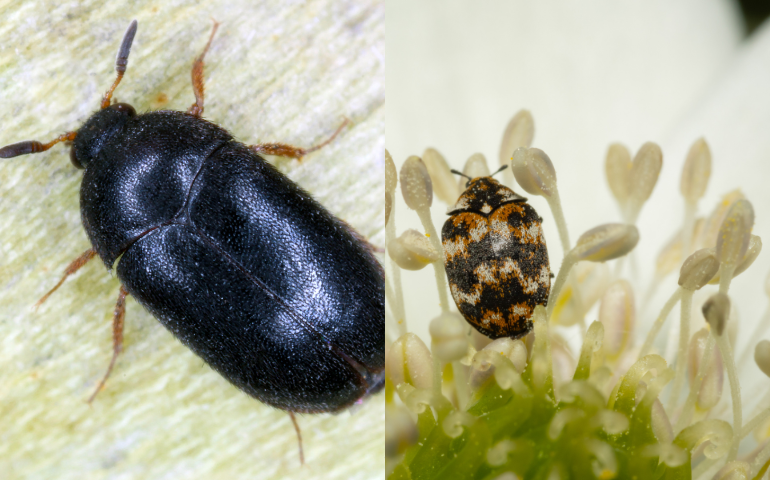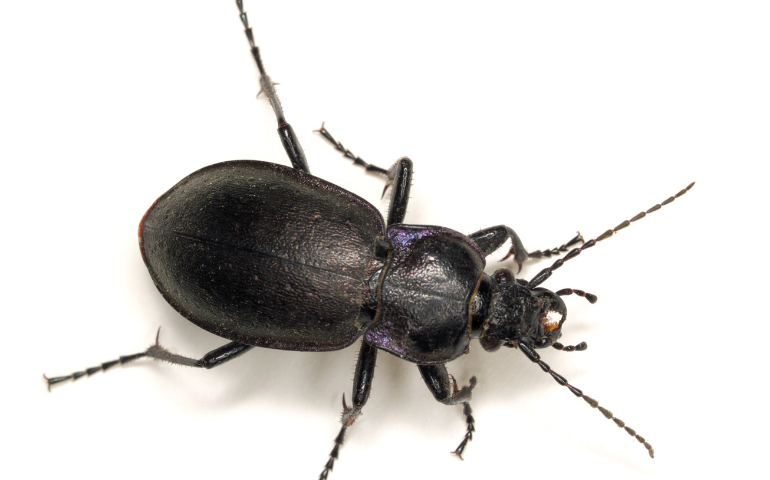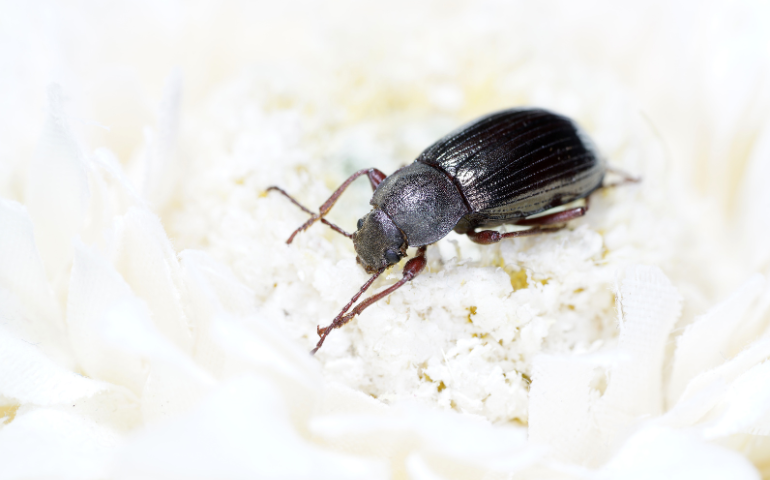We hear it all the time: “I keep seeing tiny black beetles in my house—what are they, and how do I get rid of them?” If you’ve noticed little black bugs on your window sill, in your pantry, or scurrying across the floor, you’re not alone. These beetles are more than just an eyesore—they can be a sign of an infestation and may cause damage to items around your home if not addressed.
Let’s break down what you’re dealing with and what to do next.
Common Types of Little Black Beetles Found Indoors
Not all black beetles are the same. Here are a few of the most common beetle species we see in homes:
Carpet Beetles (including the varied carpet beetle and black carpet beetle)

Carpet beetles are some of the most common household beetles we encounter. They’re tiny—typically less than 1/4 inch long—and can be black, mottled, or dark brown depending on the species. You’ll often find them near window sills, baseboards, air vents, or tucked into corners of closets and drawers. Adult carpet beetles can fly and are often attracted to light, which is why they tend to gather near windows. They frequently enter homes from the outside during warmer months, especially through open windows, doors, or attic vents. While the adults feed on pollen and aren’t harmful indoors, their larvae cause damage by feeding on wool, fur, feathers, silk, leather, and even pet hair. Most infestations are only noticed once you start seeing damage to clothing, furniture, or rugs.
Ground Beetles

Ground beetles—or what many people call “big black beetles”—while still little, are typically larger than most household beetles and have a shiny black or dark brown appearance with long legs. They’re fast crawlers but do not fly or jump. Ground beetles usually enter homes by accident through gaps under doors, garage thresholds, or windows, especially after rain or landscaping work. They don’t reproduce indoors or pose a threat to your home’s structure, but their sudden presence can definitely catch you off guard. Most commonly found in basements, mudrooms, or along ground-level walls.
Drugstore Beetles or Flour Beetles

These tiny pantry pests are often confused with black beetles due to their shape and size. Drugstore beetles are reddish-brown with a rounded back and can fly, especially when disturbed. Flour beetles, on the other hand, are flatter, more elongated, and typically reddish-brown to dark brown—but not truly black. Some species can fly while others cannot. Both types feed on stored dry goods like flour, cereal, rice, spices, dried pasta, and pet food. If you’re seeing tiny beetles crawling or flying around your kitchen, pantry shelves, or even inside sealed packages, it’s time to check your dry goods for signs of infestation.
Spider Beetles

Spider beetles are small, dark beetles that can easily be mistaken for spiders or bed bugs because of their rounded bodies and long legs. They do not fly or jump, but their slow, erratic crawling movement can make them appear like they’re hopping. These beetles are scavengers, usually found in dark, undisturbed places like attics, wall voids, pantries, or near rodent nesting sites. They feed on a wide range of materials including grains, pet food, feathers, wool, and stored organic matter. If you’re spotting tiny black bugs in quiet corners, cabinets, or crawl spaces, spider beetles might be what you’re seeing.
How Are They Getting Inside?
Most beetles sneak in through tiny cracks and crevices around doors, windows, utility lines, and attics. Others may hitch a ride inside on groceries, plants, used furniture, or pet food. Some species, like the black carpet beetle, are attracted to light and warmth—so it’s not uncommon to find them near windows or light fixtures.
If you’ve recently brought home bird seed, grains, dried flowers, or even secondhand rugs or furniture, these could be the source.
What Attracts Beetles to My Home?
These insects are usually drawn in by food, moisture, or shelter. For example:
- Carpet beetles seek out lint, pet hair, feathers, fur, and fabric.
- Pantry pests are looking for cereal, flour, rice, and grains.
- Ground beetles and other outdoor beetles may come inside by accident, especially after rain or landscaping work.
If you’ve seen beetles near the kitchen, bathroom, laundry room, or attic—those are common areas thanks to accessible food, humidity, and clutter.
How to Get Rid of Tiny Black Beetles in Your House
If you’re seeing tiny black beetles around your home—on window sills, in the pantry, or crawling across the floor—you’re probably wondering how to get rid of them for good. While they may seem harmless at first, these beetles can quickly multiply and become a bigger issue. Below, we’ll break down why DIY methods usually fall short, how our professional treatments work, and what you can do between visits to keep your home beetle-free.
Why DIY and Natural Remedies Fall Short
We get asked about natural beetle repellents a lot—especially essential oils like peppermint or eucalyptus. While these can help deter beetles temporarily, they don’t solve the underlying problem. Sprays wear off quickly, and beetles often hide in walls, carpets, or insulation—far beyond where natural remedies can reach.
Diatomaceous earth can be helpful when used correctly, but it’s not a long-term fix. It only works on insects that crawl directly through it, and it becomes ineffective in damp areas or after cleaning.
Our Approach to Beetle Control
At Alta Pest Control, we take a long-term approach to protecting your home from beetles and other pests. Here’s how our service works:
1. Call to Get Started: The first step is to give us a call. We’ll help you confirm if we service your area, walk you through what to expect, and get your first treatment scheduled. If you’re unsure what type of pest you’re dealing with, we can also set up a free inspection to identify the pest and recommend the best treatment plan.
2. Initial Treatment: We apply a commercial-grade barrier around your home using child- and pet-friendly products that target beetles and other common pests.
3. De-webbing and Granules: We remove spider webs from your eaves and spread granules around your yard to reduce pest pressure from the outside in.
4. Ongoing Protection: Our general pest control plan includes quarterly treatments to keep pests like beetles from coming back—and if you see activity between visits, we’ll re-treat at no extra cost.
This approach is much more effective than one-time sprays or home remedies. It targets the source of the problem and keeps your home protected throughout every season.
We back every service with our 100% satisfaction guarantee—so no matter what kind of pest you’re dealing with, we’ll take care of it for good.
What to Do Between Treatments
While our quarterly plan offers strong protection, there are a few things you can do between visits to prevent beetles from coming back:
- Store dry goods in sealed containers (especially flour, cereal, and pet food)
- Vacuum regularly, especially in corners, under furniture, and along baseboards
- Reduce humidity in attics, basements, and bathrooms with a dehumidifier
- Wash infested fabrics in hot water and dry thoroughly
- Clean window sills, pantry shelves, and other hotspots
If beetles have laid eggs in your carpet, furniture, or pantry items, vacuuming and deep cleaning can help reduce their numbers while we treat.
When to Call for Help
If you’ve tried to manage beetles on your own and they keep showing up—or if you’re not sure what kind of beetle you’re dealing with—it’s time to call in a professional. Some infestations, especially with species like dermestid beetles or pantry pests, can grow quickly and require targeted treatment.
We’re here to help you identify the problem and eliminate it for good. Our team is trained to spot signs of activity, locate hidden sources, and treat in ways that are effective without disrupting your household.
Let’s Keep Your Home Beetle-Free
At Alta Pest Control, we believe in doing more than just spraying and leaving. Our knowledgeable, reliable technicians keep you informed, explain what we’re doing, and always treat your home like it’s our own. With child- and pet-friendly treatments, thousands of 5-star reviews, and free re-treatments between visits, we’re here to make pest control easier—and more effective.
Let’s take those beetles to a better place. Contact us today to schedule your first service.
Share article:
